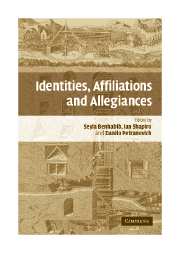Book contents
- Frontmatter
- Contents
- List of figures
- List of tables
- List of contributors
- Editors' introduction
- Part I Emergence and limits of national political identities
- Part II Multiple identities in practice: the European example
- 5 Building European institutions: beyond strong ties and weak commitments
- 6 Soft borders and transnational citizens
- 7 Transnational nationalism: redefining nation and territory
- Part III Decoupling citizenship from identity
- Part IV Identity and historical injustice
- References
- Index
7 - Transnational nationalism: redefining nation and territory
Published online by Cambridge University Press: 05 June 2012
- Frontmatter
- Contents
- List of figures
- List of tables
- List of contributors
- Editors' introduction
- Part I Emergence and limits of national political identities
- Part II Multiple identities in practice: the European example
- 5 Building European institutions: beyond strong ties and weak commitments
- 6 Soft borders and transnational citizens
- 7 Transnational nationalism: redefining nation and territory
- Part III Decoupling citizenship from identity
- Part IV Identity and historical injustice
- References
- Index
Summary
In 1992, at the signature of the Maastricht treaty, when the European Union counted twelve member states, some leaders of immigrants' voluntary associations involved in building transnational solidarity networks talked about themselves as the “thirteenth population” or the “thirteenth state,” or even the “thirteenth nation.” Such a formulation suggests a feeling of collective belonging through transnationality and a will to consolidate their solidarity as a political community that transcends member states. But the “thirteenth” idea points also to the emergence of “transnational communities” on a European level, that is, communities structured by individuals or groups settled in different national societies who share some common reference – national, ethnic, religious, linguistic – and define their common interest beyond boundaries. In a broader sense, such transnational communities take into account the context of globalization and economic uncertainty that facilitates the construction of world-wide networks. Their institutionalization requires a coordination of activities, resources, information, technology, and sites of social power across national borders for political, cultural, and economic purposes. Increasing mobility and the development of communications have intensified such trans-border relations, leading to social and political mobilizations that cross boundaries.
The mode of action of such a community is de-territorialized. The rhetoric of mobilization “recentralizes,” in a nonterritorial way, the multiplicity of identities – national, religious, ethnic, or linguistic – that are represented in such a structure.
- Type
- Chapter
- Information
- Identities, Affiliations, and Allegiances , pp. 159 - 178Publisher: Cambridge University PressPrint publication year: 2007
- 14
- Cited by



